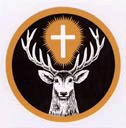|
Kildare Families
The Eustace Families of Elverstown, County Kildare The adjoining townlands of Dowdenstown (Great and Little), Barretstown and Elverstown, in Tipperkevin Parish, are about two miles north of Ballymore Eustace, and until the Dissolution in 1547 formed part of the Ballymore estates of the Archbishop of Dublin. (There is liable to be confusion between these two townlands and those of Dowdingstown and Barrettstown (south and west of Naas), which were also Eustace lands; see Castlekeely). Dowdenstown is mentioned by De Burgo as the seat of one of the very earliest branches of the Eustace family, but confirmatory references are rare. In Archbishop Allen’s Register it is recorded for the period 1256-66 that “Eustace son of Godfrey” paid wax- rent, with a note by the Archbishop “perhaps for Barretstown.” (If Eustace, son of Godfrey was a member of the Eustace family, this is the earliest reference to the name that the author has met.) In 1326 John FitzEustace (see Newland) held from the Archbishop two carcurates in Dowdenstown. (A carcurate was 100-120 acres (say 160-200 statute but excluded wood land, pasture and bog. The Dowdenstowns are now 447 acres statute and Tipperkevin is 280 acres. Head-rents were 10/ in 1326 and 57/ in 1361.) In 1361 the head-rents of Dowdenstown and Tipperkevin, just north of it, were granted by the Archbishop to William Greuett, who sold them in 1401 to Nicholas Eustace of Dublin (see Confey), the lands at that time being held by Richard Eustace, grandson of John FitzEustace. The head-rents were paid to the Eustaces of Confey in 1532 by James, John and Henry Eustace, while Barretstown was held by Oliver Eustace direct from the Archbishop. The fate of these lands at the time of the Dissolution is not known but by the mid-sixteenth century we find constant references to Eustaces settled in this area. Walter of Elverstown and Alexander of Dowdenstown lost their estates in 1641, but Alexander who died in 1643 was declared in 1663 to have been an innocent Papist and the lands restored to his son Walter. (Walter Eustace’s lands included 403 acres in Tipperkevin partly from Baltinglass forfeitures. They included Morganstown, Elverstown (180 acres), Burgagemocle (10 acres) and 42 acres near Ballymore Eustace called Talbot’s and Bennett’s lands. The estate contained four castles. Forenaughts Great had been mortgaged to Alexander in 1640 to save it from confiscation.) Walter Eustace appears to have been succeeded by a nephew Colonel Richard Eustace of Dowdenstown and Barretstown, son of Maurice who died in 1660. Colonel Richard Eustace, having been commissioned an ensign in 1673 and captain in 1681, he was lieutenant-colonel and second-in-command of Lord Gormanston’s (the 9th) Regiment in King James’s army, and was wounded at both Derry and Aughrim. His lands, forfeited in 1690, were restored under the Treaty of Limerick. Richard Eustace first married in 1670 Dorothy Hill, great-aunt of Viscount Hillsborough (father of 1st Marquess of Downshire), and their daughter, Anne, married James Eustace of Yeomanstown. He married secondly Margaret, daughter of Thomas Aylmer of Lyons, by whom he had a son Maurice Eustace on whose death the estate passed from the family. (Margaret Eustace, nee Aylmer claimed in 1719 against the estate of Sir Maurice Eustace of Harristown for a legacy bequeathed to her son Maurice, and also for a debt owed jointly to him and Richard of Naas (deceased vide p. 336). Dowdenstown and Barretstown was later owned by the Borrowes family, Baronets of Giltown, who housed the Kilcullen effigy (q.v.) until they vacated Barretstown in 1919. See also Tipperkevin Alexander Eustace of Dowdenstowne Records in National Archives of Ireland (Ball Papers) These pages © Ronald Eustice, 2007 |
